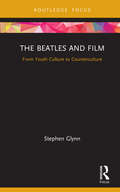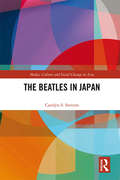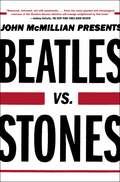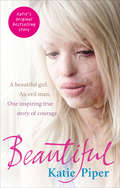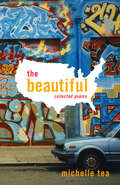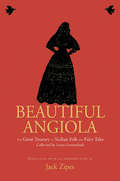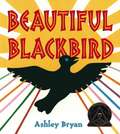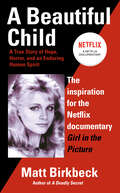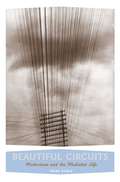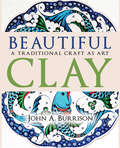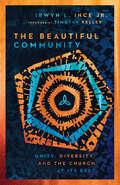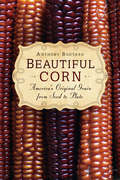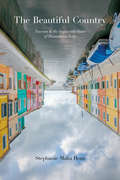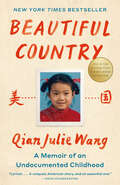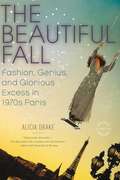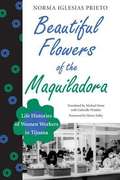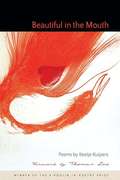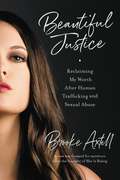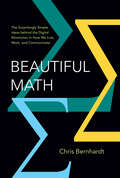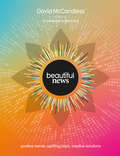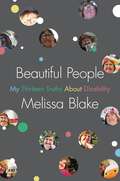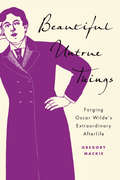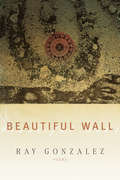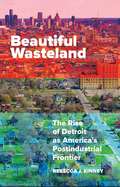- Table View
- List View
The Beatles and Film: From Youth Culture to Counterculture (Cinema and Youth Cultures)
by Stephen GlynnThis concise yet comprehensive study explores the emblematic journey by four young men from Liverpool from the epicentre of teen-led youth culture to the experimentation of the counterculture and beyond. Beginning with the celebration of Britain’s own ‘youthquake’ in the joyous and genre-shifting A Hard Day’s Night (1964), the author delves into how the Beatles’ film work allows us to chart their subsequent musical maturation and retreat from the tribulations of stardom in Help!, their tentative attempts at improvised filming in the televised Magical Mystery Tour (1967), their acceptance of cartoon representations as leaders of the hippie counterculture in Yellow Submarine (1968), and the final implosion of their musical dynamic in the recording studios of Let It Be (1970). The book analyses how, as they grew with their fanbase, the Beatles’ films alternate stylistically between mimetic representation and allegorical interpretation, and switch narratively between fan-filled and welcoming worlds, to films relaying introspection and isolation. Offering an in-depth case study of the successes and failures of British youth culture in a volatile decade, The Beatles and Film is an engaging text for both scholars and general readers alike.
The Beatles in Japan (Media, Culture and Social Change in Asia)
by Carolyn S. StevensFollowing their first tour to Japan in 1966, the Beatles would become an important part of Japan’s postwar cultural development and its deepening relationship with the West. By the 1960s Japan’s dramatic rise in prosperity and the self-confidence of the country’s ‘economic miracle’ period were yet to come; it was not, at this stage, considered a fully-fledged partner of the West. All these potential developments were consolidating around the time of the 1966 tour. The Beatles' concerts in Tokyo contributed to the construction of a new Japanese national identity and introduced Japan as a new potential market to UK and US music producers, broadening the country’s transnational cultural links. This book explores the Beatles’ engagement with Japan within the larger context of the country’s increased global connection and large-scale economic, social and cultural change. It describes the great impact of the Beatles’ contentious 1966 tour, which took place amid public displays of both euphoric ‘Beatlemania’ and angry protests, and discusses the lasting impression of this tour on Japanese culture and identity to the present day. The Beatles’ relationship with Japan did not end after their departure; this book also examines the Beatles’ subsequent contacts with Japan, including John Lennon’s marriage and artistic partnership with Yoko Ono, and Paul McCartney’s later Japanese tours and the warm reception the ex Beatles and their musical legacy have received over the years.
Beatles vs. Stones
by John McmillianIn the 1960s an epic battle was waged between the two biggest bands in the world--the clean-cut, mop-topped Beatles and the badboy Rolling Stones. Both groups liked to maintain that they weren't really "rivals"--that was just a media myth, they politely said--and yet they plainly competed for commercial success and aesthetic credibility. On both sides of the Atlantic, fans often aligned themselves with one group or the other. In Beatles vs. Stones, John McMillian gets to the truth behind the ultimate rock and roll debate.Painting an eye-opening portrait of a generation dragged into an ideological battle between Flower Power and New Left militance, McMillian reveals how the Beatles-Stones rivalry was created by music managers intent on engineering a moneymaking empire. He describes how the Beatles were marketed as cute and amiable, when in fact they came from hardscrabble backgrounds in Liverpool. By contrast, the Stones were cast as an edgy, dangerous group, even though they mostly hailed from the chic London suburbs. For many years, writers and historians have associated the Beatles with the gauzy idealism of the "good" sixties, placing the Stones as representatives of the dangerous and nihilistic "bad" sixties. Beatles vs. Stones explodes that split, ultimately revealing unseen realities about America's most turbulent decade through its most potent personalities and its most unforgettable music.
Beautiful: A beautiful girl. An evil man. One inspiring true story of courage
by Katie Piper'I heard a horrible screaming sound, like an animal being slaughtered ... then I realised it was me.'When Katie Piper was 24, her life was near perfect. Young and beautiful, she was well on her way to fulfilling her dream of becoming a model.But then she met Daniel Lynch on Facebook and her world quickly turned into a nightmare ...After being held captive and brutally raped by her new boyfriend, Katie was subjected to a vicious acid attack. Within seconds, this bright and bubbly girl could feel her looks and the life she loved melting away.Beautiful is the moving true story of how one young woman had her mind, body and spirit cruelly snatched from her and how she inspired millions with her fight to get them back.
The Beautiful
by Michelle TeaBefore she wrote prose, Michelle Tea was a poet. This expansive, fiery volume collects Tea's early chapbooks along with previously unpublished poems, making vivid Tea's own life, from the dysfunctional family household she left in New England through college and the Tucson sex trade, to the happier life she made for herself on the West Coast.
Beautiful Angiola: The Lost Sicilian Folk and Fairy Tales of Laura Gonzenbach
by Jack ZipesIn one of the most startling literary discoveries of recent years, Jack Zipes has uncovered this neglected treasure trove of Sicilian folk and fairy tales. Like the Grimm brothers before her, Laura Gonzenbach, a talented Swiss-German born in Sicily, set out to gather up the tales told and retold among the peasants. Gonzenbach collected wonderful stories - some on subjects that readers will know from the Grimms or Perrault, some entirely new - and published them in German. Her early death and the destruction of her papers in the Messina earthquake of 1908 only add to the mystery behind her achievement. Beautiful Angiola is an instant classic: a nineteenth-century collection of stories in the great tradition of fairy and folk tales now translated into English for the first time. Gonzenbach delights us with heroines and princes, sorcery and surprise, the deeds of the brave and the treacherous, and the magic of the true storyteller. The Green Bird , The Humiliated Princess , sorfarina , The Magic Cane, the Golden Donkey, and the Little Stick that Hits are titles destine to become new favourites for readers everywhere. Yet while the stories enchant us, the wry taglines with which they often end ('And so they remained rich and consoled, while we keep sitting here and are getting old') gently bring us back to earth.
Beautiful Blackbird
by Ashley BryanBlack is beautiful, uh-huh! Long ago, Blackbird was voted the most beautiful bird in the forest. The other birds, who were colored red, yellow, blue, and green, were so envious that they begged Blackbird to paint their feathers with a touch of black so they could be beautiful too. Although Black-bird warns them that true beauty comes from within, the other birds persist and soon each is given a ring of black around their neck or a dot of black on their wings -- markings that detail birds to this very day. Coretta Scott King Award-winner Ashley Bryan's adaptation of a tale from the Ila-speaking people of Zambia resonates both with rhythm and the tale's universal meanings -- appreciating one's heritage and discovering the beauty within.
A Beautiful Child: A True Story Of Hope, Horror, And An Enduring Human Spirit
by Matt BirkbeckSharon Marshall was a brilliant and beautiful student whose future was filled with promise. But her murderous, fugitive father had drawn her into a lifetime of deception that became one of the most baffling cases in the annals of American crime.
Beautiful Circuits: Modernism and the Mediated Life
by Mark GobleConsidering texts by Henry James, Gertrude Stein, James Weldon Johnson, F. Scott Fitzgerald, Ralph Ellison, Richard Wright, James Agee, and William Carlos Williams, alongside film, painting, music, and popular culture, Mark Goble explores the development of American modernism as it was shaped by its response to technology and an attempt to change how literature itself could communicate.Goble's original readings reinterpret the aesthetics of modernism in the early twentieth century, when new modes of communication made the experience of technology an occasion for profound experimentation and reflection. He follows the assimilation of such "old" media technologies as the telegraph, telephone, and phonograph and their role in inspiring fantasies of connection, which informed a commitment to the materiality of artistic mediums. Describing how relationships made possible by technology became more powerfully experienced with technology, Goble explores a modernist fetish for media that shows no signs of abating. The "mediated life" puts technology into communication with a series of shifts in how Americans conceive the mechanics and meanings of their connections to one another, and therefore to the world and to their own modernity.
Beautiful Clay: A Traditional Craft as Art
by John A. BurrisonFor most of human history, all pottery was what we would now consider traditional folk pottery. Not all artifacts go beyond the basic requirements of utility in pursuit of beauty, but Beautiful Clay considers those that do.In Beautiful Clay, noted scholar of traditional ceramics John A. Burrison writes about how a potter applies aesthetics to utilitarian objects to transform raw clay into something beautiful. Though what is considered beautiful in art changes from culture to culture and person to person, there are universal techniques such as manipulating form, color, texture, and more that tap into clay's potential for beauty. Burrison uses an approach from a perspective of international artistry rather than an approach bound by history or geography. After beginning with more than 40,000 images that the author curated as a study resource, Beautiful Clay narrows it down to around 230 images that capture the artistry within traditional ceramics worldwide.Beautiful Clay examines the aesthetic dimensions of what is essentially a traditional utilitarian craft, the ancient clay-based craft of pottery, from earliest times to the present.
The Beautiful Community: Unity, Diversity, and the Church at Its Best
by Irwyn L. Ince Jr.The church is at its best when it pursues the biblical value of unity in diversity. Our world has been torn asunder by racial, ethnic, and ideological differences. It is seen in our politics, felt in our families, and ingrained in our theology. Sadly, the church has often reinforced these ethnic and racial divides. To cast off the ugliness of disunity and heal our fractured humanity, we must cultivate spiritual practices that help us pursue beautiful community. In The Beautiful Community, pastor and theologian Irwyn Ince boldly unpacks the reasons for our divisions while gently guiding us toward our true hope for wholeness and reconciliation. God reveals himself to us in his trinitarian life as the perfection of beauty, and essential to this beauty is his work as Father, Son, and Holy Spirit. The gospel imperative to pursue the beautiful community—unity in diversity across lines of difference—is rooted in reflecting the beautiful community of our triune God. This book calls us into and provides tools for that pursuit.
Beautiful Corn: America's Original Grain from Seed to Plate
by Anthony BoutardCultivated from sea level to mountaintop, from parched deserts to sodden rain forests, from the rocky Gaspé Peninsula to the plains of Argentina, corn is the grain of the Americas. In terms of culinary uses, it is amazingly diverse, reflecting the breathtaking variety of the continents and environments from which it evolved. The consummate immigrant, corn is grown extensively on every continent except Antarctica. Market farmer and naturalist Anthony Boutard weaves together this unique plant's contribution to our culture, its distinctive biology, and the practical information needed to grow and enjoy it at home. Beautiful Corn advocates a return to the nourishing whole grain that built America, in place of today's genetically modified crops processed by industrial agriculture into synthetic sweeteners and cheap meat. Come along on this lyrical and inspiring journey through the seasons, learning about growing and using corn in the traditional way. Gardeners and market farmers can lead the way to a healthier country by restoring heritage corn varieties to our tables. An unabashed celebration of a much-maligned culinary treasure, Beautiful Corn will forever change the way you view this remarkable plant. Anthony Boutard is a widely recognized advocate in the local food movement, well-known for his efforts in reviving long-lost crops and bringing little-known varieties to market. He and his wife Carol own Ayers Creek Farm, a 144-acre organic market farm in Gaston, Oregon, specializing in berries, beans, grains, and greens for sale to local restaurants and markets.
The Beautiful Country: Tourism and the Impossible State of Destination Italy
by Stephanie Malia HomEvery year, Italy swells with millions of tourists who infuse the economy with billions of dollars and almost outnumber Italians themselves. In fact, Italy has been a model tourist destination for longer than it has been a modern state. The Beautiful Country explores the enduring popularity of “destination Italy,” and its role in the development of the global mass tourism industry. Stephanie Malia Hom tracks the evolution of this particular touristic imaginary through texts, practices, and spaces, beginning with the guidebooks that frame Italy as an idealized land of leisure and finishing with destination Italy’s replication around the world. Today, more tourists encounter Italy through places like Las Vegas’s The Venetian Hotel and Casino or Dubai’s Mercato shopping mall than experience the country in Italy itself. Using an interdisciplinary methodology that includes archival research, ethnographic fieldwork, literary criticism, and spatial analysis, The Beautiful Country reveals destination Italy’s paramount role in the creation of modern mass tourism.
Beautiful Country: A Memoir of an Undocumented Childhood
by Qian Julie WangA NEW YORK TIMES BEST SELLER • The moving story of an undocumented child living in poverty in the richest country in the world—an incandescent debut from an astonishing new talent • A TODAY SHOW #READWITHJENNA PICK In Chinese, the word for America, Mei Guo, translates directly to &“beautiful country.&” Yet when seven-year-old Qian arrives in New York City in 1994 full of curiosity, she is overwhelmed by crushing fear and scarcity. In China, Qian&’s parents were professors; in America, her family is &“illegal&” and it will require all the determination and small joys they can muster to survive.In Chinatown, Qian&’s parents labor in sweatshops. Instead of laughing at her jokes, they fight constantly, taking out the stress of their new life on one another. Shunned by her classmates and teachers for her limited English, Qian takes refuge in the library and masters the language through books, coming to think of The Berenstain Bears as her first American friends. And where there is delight to be found, Qian relishes it: her first bite of gloriously greasy pizza, weekly &“shopping days,&” when Qian finds small treasures in the trash lining Brooklyn&’s streets, and a magical Christmas visit to Rockefeller Center—confirmation that the New York City she saw in movies does exist after all.But then Qian&’s headstrong Ma Ma collapses, revealing an illness that she has kept secret for months for fear of the cost and scrutiny of a doctor&’s visit. As Ba Ba retreats further inward, Qian has little to hold onto beyond his constant refrain: Whatever happens, say that you were born here, that you&’ve always lived here.Inhabiting her childhood perspective with exquisite lyric clarity and unforgettable charm and strength, Qian Julie Wang has penned an essential American story about a family fracturing under the weight of invisibility, and a girl coming of age in the shadows, who never stops seeking the light.
The Beautiful Fall: Fashion, Genius, and Glorious Excess in 1970s Paris
by Alicia Drake"Deliciously dramatic... The Beautiful Fall crackles with excitement."-New York Times Book Review In the 1970s, Paris fashion exploded like a champagne bottle left out in the sun. Amid sequins and longing, celebrities and aspirants flocked to the heart of chic, and Paris became a hothouse of revelry, intrigue, and searing ambition. At the center of it all were fashion's most beloved luminaries - Yves Saint Laurent, the reclusiveenfant terrible,and Karl Lagerfeld, the flamboyant freelancer with a talent for reinvention - and they divided Paris into two fabulous halves. Their enduring rivalry is chronicled in this dazzling exposé of an era: of social ambitions, shared obsessions, and the mesmerizing quest for beauty. "Fascinating." - New York Times "Addictive." - Philadelphia Inquirer "It's like US Weekly, 1970s style." - Gotham "A story constructed as exquisitely as a couture dress. . . . It moves stylishly forward, with frequent over-the-shoulder glances at some very dishy background." - Boston Globe
Beautiful Flowers of the Maquiladora: Life Histories of Women Workers in Tijuana
by Iglesias Prieto NormaPublished originally as La flor mas bella de la maquiladora, this beautifully written book is based on interviews the author conducted with more than fifty Mexican women who work in the assembly plants along the U. S. –Mexico border. A descriptive analytic study conducted in the late 1970s, the book uses compelling testimonials to detail the struggles these women face. The experiences of women in maquiladoras are attracting increasing attention from scholars, especially in the context of ongoing Mexican migration to the country’s northern frontier and in light of the North American Free Trade Agreement (NAFTA). This book is among the earliest accounts of the physical and psychological toll exacted from the women who labor in these plants. Iglesias Prieto captures the idioms of these working women so that they emerge as dynamic individuals, young and articulate personalities, inexorably engaged in the daily struggle to change the fundamental conditions of their exploitation.
Beautiful in the Mouth (A. Poulin, Jr. New Poets of America)
by Keetje KuipersThomas Lux selected this debut collection as winner of BOA&’s A. Poulin, Jr., Poetry Prize. In his foreword he writes, "I was immediately struck by the boldness of imagination, the strange cadences, and wild music of these poems. We should be glad that young poets like Keetje Kuipers are making their voices heard not by tearing up the old language but by making the old language new."Keetje Kuipers, a native of the Northwest, earned her BA at Swarthmore College and MFA at the University of Oregon. A Stegner Fellow at Stanford University, she divides her time between Stanford and Missoula, Montana.
Beautiful in the Mouth
by Keetje Kuipers Thomas LuxThomas Lux selected this debut collection as winner of BOA's A. Poulin, Jr., Poetry Prize. In his foreword he writes, "I was immediately struck by the boldness of imagination, the strange cadences, and wild music of these poems. We should be glad that young poets like Keetje Kuipers are making their voices heard not by tearing up the old language but by making the old language new."Keetje Kuipers, a native of the Northwest, earned her BA at Swarthmore College and MFA at the University of Oregon. A Stegner Fellow at Stanford University, she divides her time between Stanford and Missoula, Montana.
Beautiful Justice: Reclaiming My Worth After Human Trafficking and Sexual Abuse
by Brooke AxtellA story of healing and a guide to seeking justice after sexual abuse from Brooke Axtell, one of the foremost survivor experts on sexual assault, domestic violence, and human traffickingWhen Brooke Axtell was seven years old, her nanny subjected her to sex trafficking. Today, she is a champion and advocate for women around the world who have experienced sexual violence and trauma.Beautiful Justice shares Brooke's own gripping story, both the trauma of sex trafficking and also her pathway through healing, moving on, and reclaiming power. Along the way, she imparts warm wisdom for others who have experienced similar violence, providing lessons from her own life and from the thousands of women, advocates, and lawmakers she's spoken with. Relying on her own experiences and a keen awareness of public policy, she provides a clear-eyed awareness of the ways that our culture and government work against women experiencing violence around the world. Inspiring and powerfully redemptive, Brooke encourages readers to take part in a creative resistance as a path to justice.
Beautiful Math: The Surprisingly Simple Ideas behind the Digital Revolution in How We Live, Work, and Communicate
by Chris BernhardtFrom the bestselling author of Quantum Computing for Everyone, a concise, accessible, and elegant approach to mathematics that not only illustrates concepts but also conveys the surprising nature of the digital information age.Most of us know something about the grand theories of physics that transformed our views of the universe at the start of the twentieth century: quantum mechanics and general relativity. But we are much less familiar with the brilliant theories that make up the backbone of the digital revolution. In Beautiful Math, Chris Bernhardt explores the mathematics at the very heart of the information age. He asks questions such as: What is information? What advantages does digital information have over analog? How do we convert analog signals into digital ones? What is an algorithm? What is a universal computer? And how can a machine learn?The four major themes of Beautiful Math are information, communication, computation, and learning. Bernhardt typically starts with a simple mathematical model of an important concept, then reveals a deep underlying structure connecting concepts from what, at first, appear to be unrelated areas. His goal is to present the concepts using the least amount of mathematics, but nothing is oversimplified. Along the way, Bernhardt also discusses alphabets, the telegraph, and the analog revolution; information theory; redundancy and compression; errors and noise; encryption; how analog information is converted into digital information; algorithms; and, finally, neural networks. Historical anecdotes are included to give a sense of the technology at that time, its impact, and the problems that needed to be solved.Taking its readers by the hand, regardless of their math background, Beautiful Math is a fascinating journey through the mathematical ideas that undergird our everyday digital interactions.
Beautiful News: Positive Trends, Uplifting Stats, Creative Solutions
by David McCandlessIn this sequel to bestselling The Visual Miscellaneum, author David McCandless reveals unexpected—and much needed—positive developments from around the world.David McCandless creates simple, elegant ways to see and understand complex, abstract, and often obscured information important to our lives. A specialist in infographics. McCandless cuts through the noise of data overload, creating visually stunning displays that not only make facts comprehensive, but illuminates their connections and adds context, making information meaningful in beautiful and entertaining way.Designed in David McCandless’s signature style. Beautiful News focuses on fascinating positive developments at a time when the world has never seemed more dangerous and unpredictable. McCandless draws from philosophy, spirituality, ecology, society, technology, history, science, economics, and pop culture, to reveal positive trends and developments, from the invention of a breakthrough device that uses ocean forces to clean plastic from the world’s seas, to a new method of converting donated blood to the crucial “O” negative type that can be used universally.In cutting edge graphs, charts, and illustrations, David McCandless creatively visualizes unexpected and compelling relationships between diverse data sets. Among his surprising findings: almost 250 US cities have remained in the Paris Accord; there are more female CEOs in the world than ever before; a new vaccine has been developed to help protect bees; Zika is disappearing from the Americas.At a time when we are besieged by disturbing events, Beautiful News is the antidote to brighten the darkest day—a shot of positivity and good cheer that will lift the spirts and provide sorely needed hope about our world in a way never before seen.
Beautiful People: My Thirteen Truths About Disability
by Melissa BlakeWell-known disability activist and social media influencer Melissa Blake offers a frank, illuminating memoir and a call to action for disabled people and allies. In the summer of 2019, journalist Melissa Blake penned an op-ed for CNN Opinion. A conservative pundit caught wind of it, mentioning Blake&’s work in a YouTube video. What happened next is equal parts a searing view into society, how we collectively view and treat disabled people, and the making of an advocate. After a troll said that Blake should be banned from posting pictures of herself, she took to Twitter and defiantly posted three smiling selfies, all taken during a lovely vacation in the Big Apple:I wanted desperately to clap back at these vile trolls in a way that would make a statement, not only about how our society views disabilities, but also about the toxicity of our strict and unrealistic beauty standards. Of course I knew that posting those selfies wasn't going to erase the nasty names I'd been called and, the chances were, they would never even see my tweet, but that didn't matter. I wasn't doing it for them; I was doing it for me and every single disabled person who has been bullied before, online and in real life. When people mock how I look, they're not just insulting me. They're insulting all disabled people. We're constantly told that we're repulsive and ugly and not good enough to be seen. This was me pushing back against that toxic, ableist narrative.For the first time, I felt like I was doing something empowering, taking back my power and changing the story. Her tweet went viral, attracting worldwide media attention and interviews with the BBC, USA Today, the Chicago Tribune, PEOPLE magazine, Good Morning America and E! News. Now, in her manifesto, Beautiful People, Blake shares her truths about disability, writing about (among other things): the language we use to describe disabled people ableism, microaggressions, and their pernicious effects what it's like to live in a society that not only isn't designed for you, but actively operates to render you invisible her struggles with self‑image and self‑acceptance the absence of disabled people in popular culture why disabled people aren't tragic heroes Blake also tells the stories of some of the heroes of the disability rights movement in America, in doing so rescuing their incredible achievements from near total obscurity. Highlighting other disabled activists and influencers, Blake&’s work is the calling card of a powerful voice—one that has sparked new, different, better conversations about disability.
Beautiful Untrue Things: Forging Oscar Wilde’s Extraordinary Afterlife
by Gregory MackieBorrowing its title from Oscar Wilde’s essay "The Decay of Lying," this study engages questions of fraudulent authorship in the literary afterlife of Oscar Wilde. The unique cultural moment of Wilde’s early-twentieth-century afterlife, Gregory Mackie argues, afforded a space for marginal and transgressive forms of literary production that, ironically enough, Wilde himself would have endorsed. Beautiful Untrue Things recovers the careers of several forgers who successfully inhabited the persona of the Victorian era’s most infamous homosexual and arguably its most successful dramatist. More broadly, this study tells a larger story about Oscar Wilde’s continued cultural impact at a moment when he had fallen out of favour with the literary establishment. It probes the activities of a series of eccentric and often outrageous figures who inhabited Oscar Wilde’s much-mythologized authorial persona – in forging him, they effectively wrote as Wilde – in order to argue that literary forgery can be reimagined as a form of performance. But to forge Wilde and generate "beautiful untrue things" in his name is not only an exercise in role-playing – it is also crucially a form of imaginative world-making, resembling what we describe today as fan fiction.
Beautiful Wall
by Ray GonzalezBeautiful Wall takes us on a profound journey through the deserts of the Southwest where the ever-changing natural landscape and an aggressive border culture rewrite intolerance and ethnocentric thought into human history. Inextricably linked to his Mexican ancestry and American upbringing, Ray Gonzalez's new collection mounts the wall between the current realities of violence and politics, and a beautiful, never-to-be-forgotten past.Ray Gonzalez is the author of fifteen books of poetry. The recipient of numerous awards, including a 2002 Lifetime Achievement Award from the Southwest Border Regional Library Association, he is a professor at the University of Minnesota in Minneapolis, Minnesota.
Beautiful Wasteland: The Rise of Detroit as America's Postindustrial Frontier
by Rebecca J. KinneyAccording to popular media and scholarship, Detroit, the once-vibrant city that crumbled with the departure of the auto industry, is where dreams can be reborn. It is a place that, like America itself, is gritty and determined. It has faced the worst kind of adversity, and supposedly now it&’s back. But what does this narrative of &“new Detroit&” leave out? Beautiful Wasteland reveals that the contemporary story of Detroit&’s rebirth is an upcycled version of the American Dream, which has long imagined access to work, home, and upward mobility as race-neutral projects. They&’re not. As Rebecca J. Kinney shows, the narratives of Detroit&’s rise, decline, and potential to rise again are deeply steeped in material and ideological investments in whiteness. By remapping the narratives of contemporary Detroit through an extension of America&’s frontier mythology, Kinney analyzes a cross-section of twentieth and twenty-first century cultural locations—an Internet forum, ruin photography, advertising, documentary film, and print and online media. She illuminates how the stories we tell about Detroit as a frontier of possibility enable the erasure of white privilege and systemic racism. By situating Detroit as a &“beautiful wasteland,&” both desirable and distressed, this shows how the narrative of ruin and possibility form a mutually constituted relationship: the city is possible precisely because of its perceived ruin.Beautiful Wasteland tackles the key questions about the future of postindustrial America. As cities around the country reckon with their own postindustrial landscapes, Rebecca Kinney cautions that development that elides considerations of race and class will only continue to replicate uneven access to the city for the poor, working class, and people of color.
